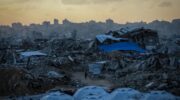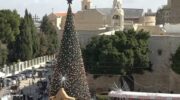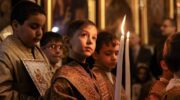A Washington Post investigation reveals that yet another Israeli claim to justify killing Palestinians was fraudulent
by Louisa Loveluck, Imogen Piper, Sarah Cahlan, Hajar Harb and Hazem Balousha, reposted from the Washington Post, March 19, 2024
JERUSALEM — On Jan. 7, the Israeli military conducted a targeted missile strike on a car carrying four Palestinian journalists outside Khan Younis, in southern Gaza.
Two members of an Al Jazeera crew — Hamza Dahdouh, 27, and drone operator Mustafa Thuraya, 30 — were killed, along with their driver. Two freelance journalists were seriously wounded.
They were returning from the scene of an earlier Israeli strike on a building, where they had used a drone to capture the aftermath. The drone — a consumer model available at Best Buy — would be central to the Israeli justification for the strike.
The Israel Defense Forces said in a statement the next day it had “identified and struck a terrorist who operated an aircraft that posed a threat to IDF troops.” Two days later, the military announced that it had uncovered evidence that both men belonged to militant groups — Thuraya to Hamas and Dahdouh to Palestinian Islamic Jihad, its smaller rival in Gaza — and that the attack had been in response to an “immediate” threat.
The Washington Post obtained and reviewed the footage from Thuraya’s drone, which was stored in a memory card recovered at the scene and sent to a Palestinian production company in Turkey. No Israeli soldiers, aircraft or other military equipment are visible in the footage taken that day — which The Post is publishing in its entirety — raising critical questions about why the journalists were targeted. Fellow reporters said they were unaware of troop movements in the area.

Interviews with 14 witnesses to the attack and colleagues of the slain reporters offer the most detailed account yet of the deadly incident. The Post found no indications that either man was operating as anything other than a journalist that day. Both passed through Israeli checkpoints on their way to the south early in the war; Dahdouh had recently been approved to leave Gaza, a rare privilege unlikely to have been granted to a known militant.
In response to multiple inquiries and detailed questions from The Post, the IDF said: “We have nothing further to add.”
The Post could not identify other instances during the war when journalists were targeted by the IDF for flying drones, which have been used extensively to capture the extent of the devastation in Gaza.
Local journalists told The Post there was no official guidance on drones from the IDF, although one reporter said an Israeli officer had privately warned him against using one. Another said he had opted not to use his drone during the conflict, fearing it could be used as a pretext for an Israeli strike.
In a statement, Al Jazeera condemned the “assassination of Mustafa and Hamza” and pledged to “take all legal measures to prosecute the perpetrators of these crimes.”
Ninety journalists and other media workers in Gaza have been killed in just over five months, according to the Committee to Protect Journalists — the deadliest period for the profession since the group began collecting data in 1992.
“It should be incumbent on the IDF to investigate what happened” on Jan. 7, Irene Khan, the U.N. special rapporteur on the promotion and protection of the right to freedom of opinion and expression, told The Post in February.
“It’s not enough to say that we suspected them so we killed them,” she said. “It’s very easy to say that in a combat situation.”

The Journalists
Israel has blocked foreign media from entering the Gaza Strip since Oct. 7, save for occasional military embeds where access is tightly controlled. To understand the conflict, the world has relied on hundreds of Palestinian journalists.
Most famous has been Wael Dahdouh, Hamza’s father and Al Jazeera’s Gaza bureau chief, whose perseverance in the face of personal tragedy has been an inspiration across the Arab world.
Wael came off air on Oct. 28 to learn that his wife, son Mahmoud and daughter Sham — Hamza’s siblings — and a grandson had been killed in their home by an Israeli airstrike. His closest colleague, Al Jazeera cameraman Samer Abu Daqqa, died of his wounds after an Israeli drone strike on Dec. 15, which also wounded Wael.
Hamza joined Al Jazeera’s Gaza bureau during the conflict, working as an assistant cameraman and a field producer, his father said.

Thuraya was a well-known freelancer, contributing photos and drone footage to Al Jazeera, as well as to Agence-France Presse, Reuters and Getty Images. He had previously worked for around five years as a photographer for the Ministry of Religious Endowments, part of Gaza’s Hamas-led government, according to Shadi al-Tabatibi, 30, a fellow journalist in the enclave. It’s not clear when his employment ended.

According to multiple friends and associates interviewed by The Post, both Dahdouh and Thuraya left Gaza City, the original focus of Israel’s military operation, in late October along a civilian evacuation route identified by the IDF.
The men lived in tents for more than two months with other journalists in the city of Rafah, an area close to the Egyptian border, where some 1.4 million displaced Palestinians have sought refuge. The journalists laid their mattresses on wooden slats to insulate their beds from the cold, they said, and traveled to the scene of airstrikes and other attacks in groups — believing there was safety in numbers.
On Jan. 6, the eve of their deaths, Dahdouh and Thuraya shared a meal with colleagues. “It was a simple dinner, but full of warmth,” said Adli Abu Taha, 33, a cameraman for Al-Kufiya TV.
Thuraya spoke to his wife and three daughters by phone, Tabatibi recalled, promising he would see them soon.
The Assignment
The journalists awoke on Jan. 7 to news of an airstrike on the home of the Abu al-Naja family, south of Khan Younis, according to a photographer for the Palestine Today television channel, Amer Abu Amr, who was also at the scene that day. The IDF later described the house as an office for Palestinian Islamic Jihad.
A social media post suggested that at least four people were killed in the strike, and that some of the dead and wounded had already been taken to the hospital.
But with more bodies believed to be under the rubble, at least 11 journalists in Rafah set out for the scene — among them Dahdouh, Thuraya, and freelance reporters Muhammad al-Qahwaji and Hazem Rajab. By 10:39 a.m., Thuraya had a drone in the air, according to the metadata of videos he filmed that day.
The footage was obtained by The Post from the Media Town production house in Istanbul, which subcontracted Thuraya’s work for Al Jazeera and other clients. The clips show reporters in blue press vests surveying a mass of mangled wires and concrete. Children watch as men pull out bodies. Civil defense workers drape blankets over the dead and carry them away.
The footage includes 38 clips and runs just over 11 minutes. Thuraya is visible at times, looking at his drone controller and letting others peer at the screen. He zooms out twice, briefly, showing the landscape to the northwest and southwest of the damaged building, about a mile in each direction. No Israeli troops, aircraft or other military equipment are visible in the footage.

At The Post’s request, two analysts reviewed available satellite imagery of the area taken by Planet Labs and Airbus on Jan. 7, covering a radius of roughly 1.2 miles from where the drone was launched. Neither expert saw any evidence of military deployments or militant activity.
William Goodhind, an open-source researcher with Contested Ground, a research project that tracks military movements in satellite imagery, said he found no sign of “armored vehicles, military trucks, strongholds, revetments, and/or rocket and mortar firing points.” He identified a police checkpoint around half a mile northwest of the drone launch but said it was unclear if it was still in use.
Preligens, a geospatial artificial intelligence firm, ran the Jan. 7 satellite imagery provided by The Post through its AI vehicle detector and did not find any armored vehicles within 9.7 square miles.
Thuraya’s drone was a commercially available Mavic 2, manufactured by the Chinese company DJI, roughly the size of a typical shoe box but slimmer. Thuraya stopped recording at 10:55 a.m., the metadata shows.
A second strike hit the site at 11:01 a.m., according to Amr, who said he and his colleague Ahmed al-Bursh were hit by shrapnel. Bursh was doubled over in pain as he stepped into a Palestine Red Crescent Society ambulance, seen in a video filmed by Amr, who joined him in the ambulance and recorded most of their ride.
“I did it out of fear,” he said. “I was afraid that we would be targeted.”


Thuraya, Dahdouh, Qahwaji, Rajab and their driver, 26-year-old Qusay Salem, who were not injured by the second strike, also fled the scene. Minutes later, an IDF video shows the sights of a military drone lock on to their vehicle, traveling just behind the ambulance. The sound of the explosion is captured in Amr’s recording from the back window of the ambulance at approximately 11:10 a.m.

Other eyewitness videos show the grisly aftermath: Thuraya and Salem were torn apart by the strike. Qahwaji was on the ground, bleeding heavily, as medics scrambled to assemble a stretcher for him. The freelancer’s face was burned and his jaw was split open. Rajab had severe burns and lost the use of an eye.
At the morgue, a grief-stricken Wael clutched his son’s hand and muttered softly to him. He wrapped his arms around Hamza’s wife, Wafaa, as she placed her face on her husband’s chest. Thuraya’s wife, Soraya, buried her head in his pillow and wept.
At a news conference that night in Doha, the Qatari capital, U.S. Secretary of State Antony Blinken described the killings as an “unimaginable loss.” As a parent, he couldn’t “begin to imagine the horror” that Wael had experienced, “not once, but now twice.”
The State Department declined to provide further comment.
A shifting story
The night of the attack, a battle over the narrative began. The IDF said in a statement that its aircraft had “identified and struck a terrorist who operated an aircraft that posed a threat to IDF troops.”
The next day, IDF spokesperson Daniel Hagari appeared to backtrack: “Every journalist that dies, it’s unfortunate,” he told NBC, saying the drone had made them look like “terrorists.”
In a new statement on Jan. 10, the IDF said the drone had posed an “immediate threat” to nearby soldiers, though the strike occurred approximately 15 minutes after Thuraya had stopped recording. The Post shared Thuraya’s footage with the Israeli military and asked if it could identify any moments when the drone posed a threat to its troops. “We have nothing more to add,” the IDF said.
The Jan. 10 statement also said that Israel’s military intelligence department had confirmed that Dahdouh and Thuraya were members of PIJ and Hamas, respectively.
The IDF’s justification for the strike fit “a pattern of responses that we identified even before this war,” said Sherif Mansour, the Middle East and North Africa program coordinator for the Committee to Protect Journalists — “evading responsibility, throwing accusations of terrorism on the journalists” and saying they “were in a position that threatens Israeli positions on the ground.”
Local journalists said Israel has not issued any official ban or restrictions on drones, which they described as powerful tools to convey the scale of the war’s destruction. But even before Jan. 7, one veteran reporter concluded that the footage wasn’t worth the risk.
Suliman Hijji, a videographer working in the Rafah area, decided at the war’s outset he would keep his drone grounded.
“The use of aircraft draws attention and can make individuals vulnerable targets,” he said.
A freelance journalist in Gaza who has worked for international outlets, speaking on the condition of anonymity because of safety concerns, said he had received a “general warning” from an Israel officer: “The officer told me not to be exposed to danger, and not to operate drones.”
Since Thuraya and Dahdouh were killed, “no one dares to fly any drones,” said Anat Saragusti, director of press freedom at the Union of Journalists in Israel.
The IDF did not comment on its drone policy for journalists in Gaza.
The Jan. 10 statement also linked to a document dated June 2022 with the logo and name of al-Quds Brigade, the military wing of PIJ. Dahdouh’s name appeared next to a line item for $224. The IDF mentioned a second document in the statement, allegedly naming Thuraya as a squad deputy commander in the al-Qadisiyyah Battalion of Hamas’s Gaza City Brigade, but did not make the document public and did not respond to numerous requests to review it.
The IDF also declined to answer other questions about the documents, including when they were found and whether their discovery was linked to the strike planning on Jan. 7.
Michael Milshtein, former head of the Palestinian affairs department for IDF military intelligence, said that he didn’t know whether the document with Dahdouh’s name was authentic but that it followed “the basic format for a PIJ document.”
“I really believe that if the IDF spokesman released it, it is authentic,” he added.
Other experts had doubts.
“It could be authentic, but nothing that the IDF has provided so far makes this certain,” said Erik Skare, a historian and postdoctoral researcher at the University of Oslo who has written a book on the history of PIJ. He said the use of language, particularly the phrasing of geographic areas, was unusual, as was the mix of English and Arabic text in a document supposedly intended for internal use.
Al Jazeera rejected the accusations against its reporters, characterizing them as “an attempt to justify the killing and targeting of journalists.”
Friends and family of the slain reporters pointed out they had been subject to security checks by the IDF in the weeks before their deaths. Both had traveled through checkpoints from Gaza City to reach the south. Dahdouh, they said, had received permission to leave Gaza altogether.
Six weeks after the death of his mother and two siblings — and soon before his own death — Dahdouh had been cleared to depart the blockaded enclave, according to his father and an official briefed on his case who spoke on the condition of anonymity to discuss a sensitive matter.
Securing permission probably would have required approval by COGAT, an arm of the Israeli Defense Ministry that signs off on who can enter and leave Gaza. The Post provided COGAT with Dahdouh’s name and Palestinian ID number to confirm he had been approved to leave, but received no answer.
Khan, the U.N. special rapporteur, said an investigation into the killings was urgently needed.
“If they’ve been able to provide this much information, they certainly have more information,” she said. “They have a responsibility to check, and to see whether mistakes are being made.”
Wael Dahdouh left Gaza on Jan. 17 to receive treatment for his wounds but vowed to keep reporting. Other reporters have since fled the enclave, or given up journalism, fearing they might be next.

Piper and Harb reported from London, Cahlan from Washington, and Balousha from Amman, Jordan.
Louisa Loveluck is a London-based correspondent for The Washington Post, covering global crises. She was the paper’s Baghdad Bureau Chief from 2019-2023. She was previously based in Beirut, covering the war in Syria and publishing a series of investigations. Before joining the paper, Louisa was the Daily Telegraph’s Cairo correspondent. She has reported from Iraq, Syria, Turkey, Egypt, Lebanon, Ukraine, Morocco, Tunisia and the United Kingdom.
Imogen Piper is a motion graphics reporter for The Washington Post’s Visual Forensics team. Before joining The Post, she worked as an investigator at conflict monitor Airwars. Piper was trained in visual investigative techniques by Forensic Architecture researchers and she subsequently worked with Forensic Architecture and Bellingcat to report on the police response during the Black Lives Matter protests in 2020.
Sarah Cahlan is a video reporter and one of the founding members of the Visual Forensics team. Her work combines open source and forensic technologies with traditional journalism and documentary filmmaking. She shared in a Pulitzer Prize for her reporting on the January 6 insurrection and a Dupont for her coverage of the clearing of Lafayette Square.
Hajar Harb is a London-based reporter who covered several wars in Gaza Strip while working as a field reporter for Al Masirah channel. She also reported on daily life experienced by people there. She was the first Palestinian female journalist to be sentenced to six months in prison for journalism about government corruption.
Hazem Balousha is a distinguished journalist based in Gaza and brings over two decades of experience covering security, politics and culture in the Gaza Strip and the West Bank. Throughout a career spanning more than two decades, Balousha has been a firsthand witness to the rise of Hamas to power, the Israeli blockade, multiple conflicts and the resulting upheavals for Gazan civilians.
RELATED:
- Watching the watchdogs: Israel’s attacks on journalists are backfiring
- US mainstream media lets Israel manipulate reports on killing of journalist Shireen Abu Akleh
- Canadian Journalists for Free Expression under attack
- Israel Snipers Train Their Weapons On International Press
- Mondoweiss: NYT, Reuters, Economist journalists self-censor on Israel so as not to be ‘savagely targeted’ — John Lyons
- Israeli Troops First Shot a Gaza Journalist’s Left Leg, Then His Right. And They Didn’t Stop There





